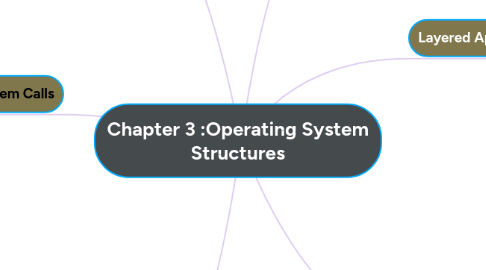
1. Operating System Services
1.1. User interface
1.2. Program execution
1.3. I/O operations
1.4. File-system manipulation
1.5. Communications
1.6. Error detection
2. System Calls
2.1. System calls provide the interface between a running program and the operating system
2.2. Three general methods are used to pass parameters between a running program and the operating system
2.3. Types of System Calls
2.3.1. Process control
2.3.2. File management
2.3.3. Device management
2.3.4. Information maintenance
2.3.5. Communications
2.3.6. Protection
3. Operating System Design
3.1. Design and Implementation of OS not “solvable”, but some approaches have proven successful
3.2. Start by defining goals and specifications
3.3. Goals
3.3.1. User goals
3.3.1.1. operating system should be convenient to use, easy to learn, reliable, safe, and fast
3.3.2. System goals
3.3.2.1. operating system should be easy to design, implement, and maintain, as well as flexible, reliable, error-free, and efficient
4. Additional Operating System Functions
4.1. Resource allocation
4.1.1. allocating resources to multiple users or multiple jobs running at the same time
4.2. Accounting
4.2.1. keep track of and record which users use how much and what kinds of computer resources for account billing or for accumulating usage statistics
4.3. Protection and security
5. Layered Approach
5.1. In layered approach, the operating system is divided into a number of layers (levels), each built on top of lower layers. The bottom layer (layer 0), is the hardware; the highest (layer N) is the user interface
5.2. Advantage
5.2.1. Simplicity of construction and debugging
5.3. Disadvantages
5.3.1. The careful definition and interaction of the layers
5.3.2. Less efficient
6. Microkernel
6.1. Small operating system core
6.2. Contains only essential core operating systems functions
6.3. Many services traditionally included in the operating system are now external subsystems
6.3.1. Device drivers
6.3.2. File systems
6.3.3. Virtual memory manager
6.3.4. Windowing system
6.3.5. Security services
6.4. Benefits of a Microkernel Organization
6.4.1. Extensibility
6.4.2. Flexibility
6.4.3. Reliability
6.4.4. Portability
